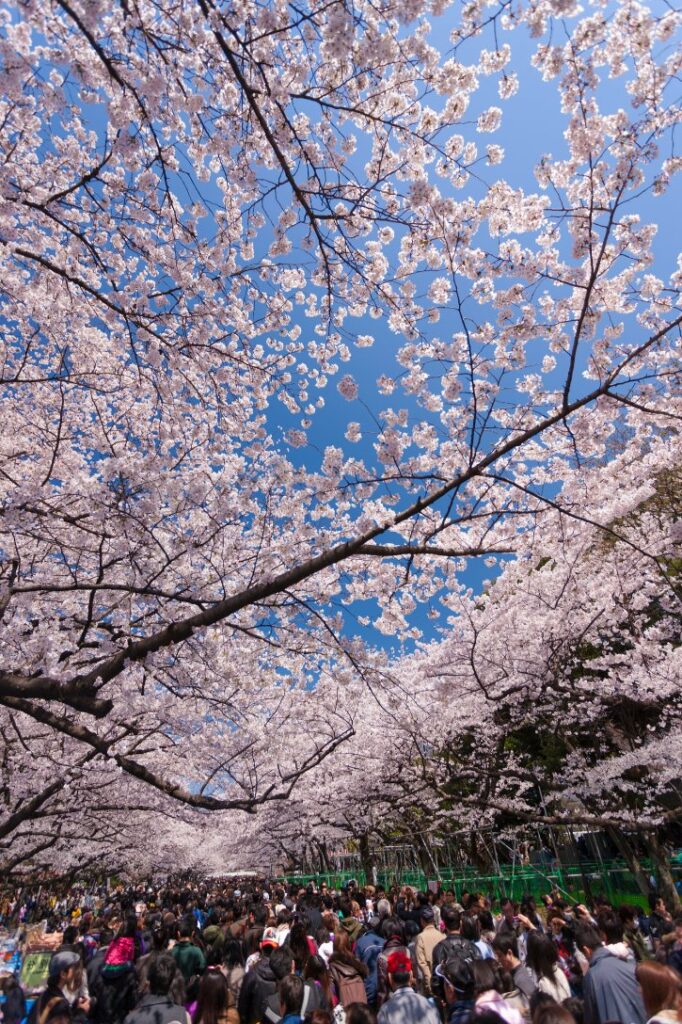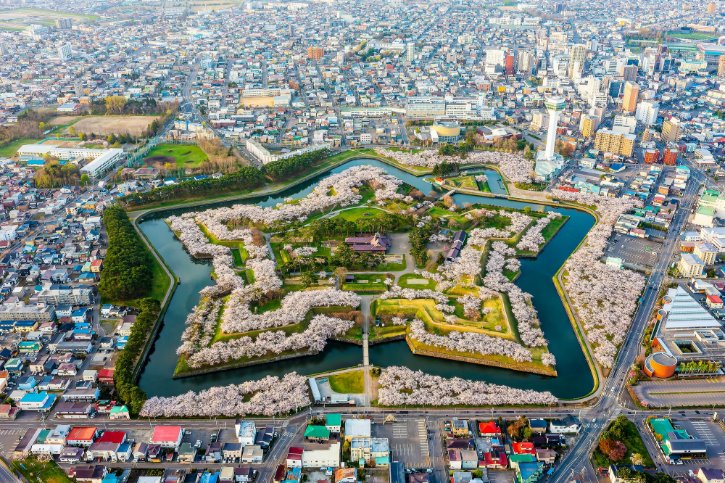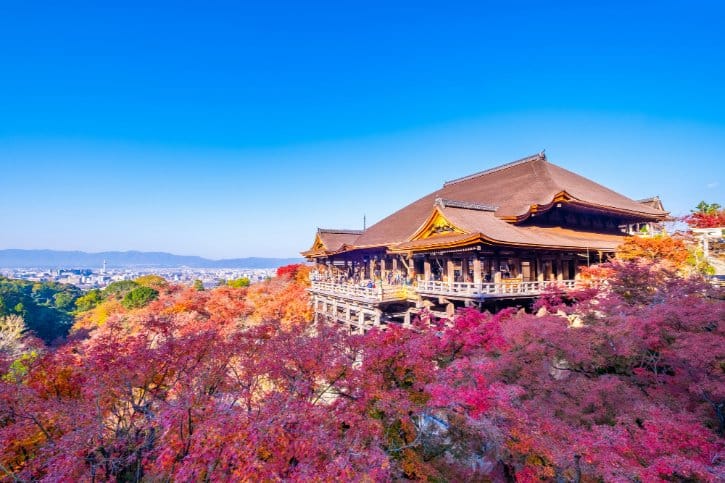
Planning a trip to Japan? While it’s a wonderful place to visit, some parts of the year can be challenging for travelers.
This guide will help you know which periods might be tricky. If possible, try to avoid these busy or uncomfortable seasons.
We’ll look at times like Golden Week and the rainy months. By choosing wisely, you can have a smoother, more enjoyable visit to Japan! 😊
1. Avoiding Late March: The Fiscal Year-End Rush
a. End of Fiscal Year Rush

- Party Pandemonium: Many Japanese companies host end-of-year parties, filling restaurants and bars.
- Business Bustle: Corporate travelers may occupy more hotel rooms than usual.
b. Crowded Tourist Spots

- End-of-Year Travels: Students and families are on the move to celebrate the end of the fiscal and school year.
- Packed Attractions: Popular destinations are bustling with domestic tourists.
c. Higher Prices Everywhere
- Increased Demand: Hotels and transportation companies hike up prices due to the surge in travelers.
- Booking Challenges: Finding affordable accommodation and transport becomes tougher.
- Overall Expense: Your entire trip budget might need to expand considerably for this period.
d. Busy Public Transport
- Overcrowded Trains and Buses: Commuting becomes less comfortable with more people on the move.
- Longer Wait Times: You might spend more time waiting for transportation.
e. A Less Relaxing Experience
- Hectic Atmosphere: The general rush can make your trip feel more stressful.
- Reduced Availability: Tours and activities may be fully booked or crowded.
f. January to Early March: A Better Alternative
- Quieter Time: Just after the fiscal year-end rush, early April marks a quieter period in Japan.
- Locals Settling In: As people adjust to new schools and jobs, tourist spots see fewer crowds, making it an ideal time for visitors.
- Pleasant Weather: The weather is pleasantly mild, perfect for exploring outdoor attractions comfortably.
- Cherry Blossoms in Bloom: With the cherry blossoms typically reaching full bloom, it’s a beautiful and peaceful time to experience Japan’s cultural and natural beauty without the hustle and bustle of peak tourist seasons.
Read More: 10 Places I Regret Not Visiting in Tokyo
2. Golden Week: Peak Tourist Season in Late April to Early May
a. Huge Crowd of Travelers and Long Waits Everywhere

- National Holidays Galore: Golden Week combines several holidays, prompting many locals to travel.
- Domestic Tourism Spike: Expect everywhere to be significantly busier.
- Queue Quandary: Expect long lines for restaurants, shops, and tourist sites.
b. Fully Booked Accommodations
- Advance Reservations Needed: Hotels and guesthouses fill up months in advance.
- Limited Options: Last-minute bookings are nearly impossible.
c. Crowded Attractions and Transport

- Packed Destinations: Sightseeing spots are flooded with visitors.
- Traffic Jams: Roads and highways see heavy congestion.
- Train Troubles: Public transportation gets packed, making travel less comfortable.
d. Festivals and Events
- Extra Crowds: While festivals are exciting, they draw even more people.
- Potential Delays: Large events can disrupt transportation schedules.
Read More: 17 Biggest Mistakes Travelers Make When Visiting Japan
3. April: Cherry Blossom Peak Season

a. Overwhelming Tourist Numbers
- Packed Viewing Spots: Famous parks and gardens become so crowded you can barely find space to stand or sit.
- Long Restaurant Waits: Even casual dining spots have hour-long waits near popular cherry blossom areas.
- Crowded Public Transport: Trains and buses to viewing locations overflow with passengers, making short trips exhausting.
b. Very High Pricess
- Hotel Price Surge: Accommodations charge double or even triple their normal rates during peak bloom.
- Booking Nightmare: You must reserve hotels six to twelve months ahead in competitive cities like Kyoto and Tokyo.
- Expensive Transportation: Flight tickets and bullet train fares also increase significantly during bloom weeks.
c. Unpredictable Timing
- Short Bloom Window: Full bloom typically lasts just five to seven days, and weather can shift the timing suddenly.
- Regional Differences: Different parts of Japan bloom at different times, making multi-city trip planning complicated.
- Stressful Planning: The pressure to catch perfect timing can overshadow the enjoyment of your trip.
d. Photography Challenges
- People Everywhere: Capturing peaceful cherry blossom photos is nearly impossible with crowds in every direction.
- Competitive Spots: Prime photo locations attract pushy visitors fighting for the best angles.
- Dawn Visits Required: Only pre-sunrise arrivals offer any chance of peaceful moments at famous sites.
e. Better Cherry Blossom Options

- Smaller Cities: Less famous towns offer equally stunning blossoms with a fraction of the crowds and lower costs.
- Different Regions: Hokkaido blooms in early May while Okinawa finishes by February, both avoiding the main tourist rush.
- Alternative Flowers: Wisteria gardens, azalea parks, and plum groves provide spectacular beauty without the frenzy.
4. The Heat of August: Japan’s Sweltering Summer
a. Intense Heat and Humidity

- Sauna-like Conditions: August is the hottest month in Japan, feeling like you’re stepping into a sauna.
- City Sizzle: Temperatures in Tokyo can soar to 35°C (95°F), with Osaka and Kyoto even hotter.
- Night Sweat: Even evenings offer little relief, with temperatures staying above 22°C (72°F).
- Physical Discomfort: The heat can make walking around exhausting.
b. Outdoor Activity Limitations
- Hiking Hassles: Many trails become uncomfortably hot and potentially dangerous.
- Sightseeing Struggle: Exploring cities on foot can be exhausting in the heat.
- Beach Crowds: Coastal areas are packed as locals seek relief from the heat.
c. Busy with Local Travelers
- School Holidays: Families take vacations, leading to more crowds.
- Event Season: Summer festivals mean more people everywhere.
d. Travel Inconveniences

- Packed Public Transport: Trains and buses can be uncomfortably crowded and hot.
- Typhoon Troubles: August is peak typhoon season, potentially disrupting travel plans.
- Energy Drain: The heat can sap your energy, making it harder to enjoy long days of sightseeing.
e. Higher Prices
- Peak Season Rates: Hotels increase prices by 30 to 50% during August.
- Limited Availability: Accommodation books up quickly due to domestic summer travel demand.
Read More: Only 3 Best Places to Stay in Tokyo
5. Late December: The Holiday Rush

a. Peak Travel Time
- New Year Celebrations: One of the most significant holidays prompts nationwide travel.
- Festive Atmosphere: While culturally rich, it’s also incredibly busy.
- Price Surge: Costs for travel and accommodation tend to increase significantly.
b. Crowded Tourist Spots

- Illumination Crowds: Winter light displays attract large numbers of visitors.
- Temple Visits: Locals flock to temples and shrines, making them extremely crowded.
- Shopping Areas Packed: Year-end sales draw large crowds to malls and markets.
c. Cold Weather Conditions
- Chilly Temperatures: Winter can be quite cold, especially if you’re not used to it.
- Snow in Some Areas: Northern regions and mountainous areas may have heavy snowfall.
d. Limited Services
- Business Closures: Some restaurants and shops close for the holidays.
- Transportation Schedules: Trains and buses may run on limited schedules.
- Transport Congestion: Bullet trains and highways become jammed December 29 to 31 and January 2 to 4 as people travel.
Read More: 11 Things You Should Never Do In Japan
6. November: Autumn Foliage High Season

a. Overwhelmed Tourist Sites
- Extremely Busy Weekends: Popular viewing locations become almost too crowded to walk through comfortably during peak color weekends.
- Kyoto Temple Chaos: Famous Kyoto temples see visitor numbers that make peaceful appreciation nearly impossible.
- Long Wait Times: You may wait an hour or more just to enter popular gardens and scenic spots.
b. Accommodation Challenges
- Advance Booking Pressure: You need to reserve hotels four to six months ahead to secure good options.
- Inflated Prices: Hotels charge 20% to 40% percent more than their standard rates during peak foliage.
- Limited Last-Minute Options: Waiting too long to book leaves you with only expensive or inconveniently located choices.
c. Crowded Attractions
- Long Queues: Expect to wait in line for popular attractions, cable cars, and viewing platforms.
- Limited Enjoyment: The sheer number of people can make it difficult to fully appreciate the natural beauty.
- Rushed Experiences: Heavy foot traffic forces you through sites faster than you’d prefer.
d. Photography Challenges
- Crowds in Every Shot: Taking serene autumn leaf photos means dealing with masses of other tourists in every frame.
- Competitive Positioning: The best viewing angles attract pushy visitors competing for space.
- Difficult Composition: Finding clear shots without people requires patience and luck.
e. Better Timing Alternative
- Early December Option: Many parts of Japan still display beautiful autumn colors in the first weeks of December.
- Post-Rush Relief: Tourist numbers drop dramatically once November ends, while foliage remains vibrant and colorful.
- Pleasant Weather Continues: Cool, comfortable weather persists into December, making outdoor exploration enjoyable.
Related Posts
Photo Credit:
Photos by PIXTA

